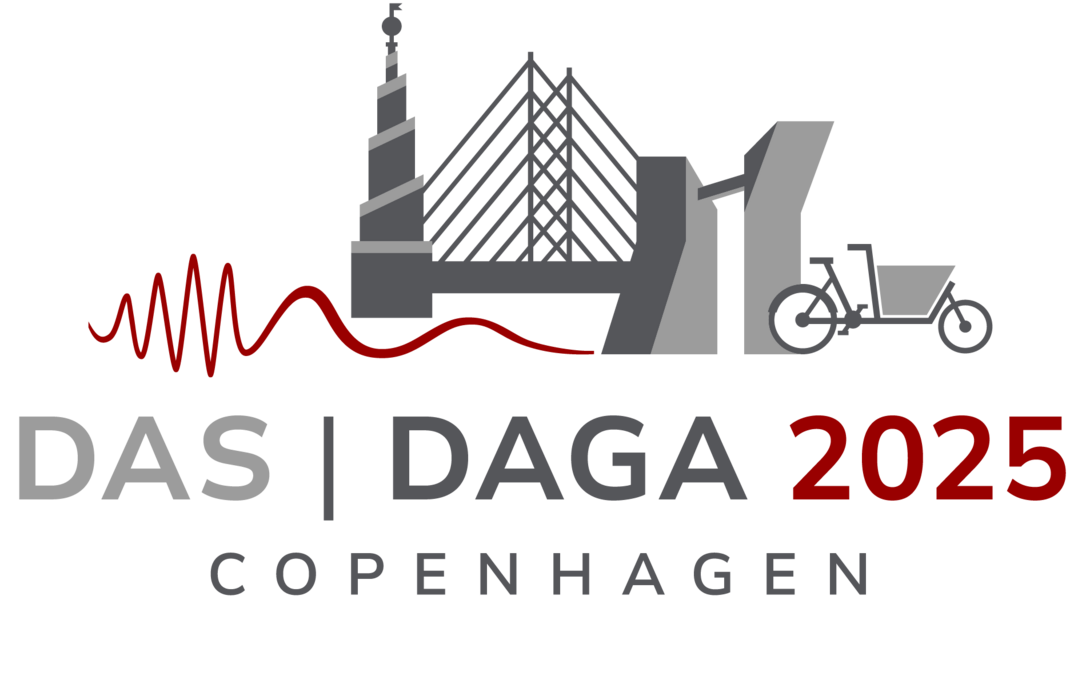Die 51. Jahrestagung für Akustik (DAGA 2025) fand in diesem Jahr in Kooperation zwischen der Deutschen Gesellschaft für Akustik (DEGA) und der Danisch Acoustical Society (DAS) vom 17. bis 20. März 2025 in Kopenhagen statt. Auch in diesem Jahr beteiligte sich das Fachgebiet Elektrische Messtechnik und berichtete über aktuelle Forschungsergebnisse aus von der DFG geförderten Forschungsprojekten.
Mareen Wippermann berichtete über die Wellenausbreitung in periodisch-strukturierten Materialien am Beispiel von faserverstärkten Kunststoffen. Die Größe und Geometrie der kleinsten Wiederholeinheit der periodischen Struktur kann mit einem erweiterten Messverfahren mit breitbandigen akustischen Wellen bestimmt werden. Diese Forschungsergebnisse entstanden im Rahmen des von der DFG geförderten Projekts FaMOUS (DFG-Projekt-Nr. 495847374), welches in Kooperation mit dem Lehrstuhl für Kunststofftechnik der Universität Paderborn bearbeitet wird.
Auch Dr. Leander Claes präsentierte im Rahmen des Forschungsprojektes FaMOUS neue Ergebnisse zur Bewertung der Faser-Matrix Haftung in faserverstärkten Kunststoffen anhand modaler Dämpfung geführter akustischer Wellen.
Olga Friesen stellte mit einem Poster die neusten Forschungsergebnisse des Forschungsgruppenprojektes NEPTUN (DFG-Projekt-Nr. 444955436) vor, welches in Kooperation mit dem Lehrstuhl für Theoretische Elektrotechnik, Lehrstuhl für Dynamik und Mechatronik, der Arbeitsgruppe Partielle Differentialgleichungen der Universität Paderborn und dem Lehrstuhl für Mathematische Optimierung der Humboldt-Universität zu Berlin bearbeitet wurde. In diesem Beitrag wird ein Messaufbau präsentiert, welcher elektrische Impedanzen von piezoelektrischen Keramiken unter variierenden elektrischen Vorspannungen erfasst.
Die Kurzfassungen aller Beiträge finden Sie nachfolgend. Sobald der Tagungsband publiziert ist, finden Sie die Quellenangaben zu den Beiträgen in der Publikationsliste des Fachgebietes.
Determination of the unit cell geometry in fibre-reinforced polymer sheets using guided acoustic waves
Authors: Mareen Wippermann, Leander Claes, Philipp Brandes, Elmar Moritzer, Bernd Henning
Woven fibre-reinforced polymers are used in a variety of application, especially where a low mass to stiffness ratio is required. Of paramount importance for the tailored mechanical properties these composite materials exhibit is the type and geometry of the fibre weave. Especially continuous fibre-reinforced thermoplastic composites are fabricated as laminates and subsequently exposed to forming processes which alter the geometry of the fibres unit cell and thus the local mechanical properties of the material. An approach utilising broadband ultrasonic waves is proposed to non-destructively determine the geometry of the unit cell of the weave.
The dispersive behaviour of woven fibre-reinforced sheets is described in accordance with the Flouquet-Bloch theorem as a phononic crystal. In order to develop a model for a description of these periodically structured waveguides, the smallest repeating unit of the wave is modelled with periodic boundary conditions. The resulting dispersion diagram exhibits similarities to that of a homogeneous plate, but additionally displays a periodicity in the wavenumber regime, which correspond with the size of the unit cell. Experimental studies of the dispersive behaviour of acoustic waves in woven fibre-reinforced samples also show a periodicity in the wavenumber regime, enabling a measurement procedure of the unit cell geometry.
Assessment of fibre-matrix adhesion in reinforced polymers by modal damping of guided acoustic waves
Authors: Leander Claes, Henning Zeipert, Philipp Brandes, Elmar Moritzer, Bernd Henning
Continuous fibre-reinforced polymers have applications in a number of different industries, including automotive and aerospace. The adhesion between the polymer matrix and the embedded fibres has a significant impact on the elastic properties of these composite components. Prior research has demonstrated that environmental factors, such as humidity, may lead to a deterioration in fibre-matrix adhesion, indicating the necessity for the development of a non-destructive testing method.
The aim of this study is to evaluate the influence of fibre-matrix adhesion on the properties of guided acoustic waves in plate-shaped specimens. Samples with modified fibre-matrix adhesion are manufactured by varying the quantity of coupling agent in the polymer. The behaviour of broadband acoustic waves is observed in the samples using a laser-induced, thermoelastic excitation. The spatiotemporal measurement data of the propagating waves is acquired and analysed in order to obtain information regarding the acoustic damping exhibited by each mode in the plate. Correlations between modal damping and fibre-matrix adhesion are investigated. To quantify the influence of the fibre-matrix adhesion on the samples' material behaviour, a viscoelastic material model is identified by solving an inverse problem in order to match the observed modal damping with the output of a waveguide simulation model.
Estimation of piezoelectric material parameters under varying electric field conditions
Authors: Olga Friesen, Lars Meihost, Kevin Koch, Leander Claes, Bernd Henning
Piezoelectric ceramics are used in high-power ultrasonic sensors and actuators, where they are subjected to considerable electrical and mechanical loads, resulting in nonlinear effects. One method for analysing the nonlinear behaviour of such materials is to shift the operating points. The application of a DC bias voltage during electrical impedance measurements results in a shift in the electrical operating point, thereby enabling the characterisation of the material's linear behaviour at the points to estimate its nonlinear properties. This study presents a measurement setup for the purpose of measuring the electrical impedance of piezoelectric ceramics under varying electrical bias voltages. Measurements are conducted with electric field strengths up to ±500 V/mm, which is representative of conditions that may be encountered in a real-world application. For samples of ring-shaped piezoceramic material with a thickness of 1 mm, the requisite direct current (DC) voltages are in the range of ±500 V. A purpose-built circuit superimposes these DC voltages on the measurement voltage. The resulting impedance measurements at each operating point are used to estimate the material parameters as a function of the applied electric field by solving an inverse problem, matching the measured electrical impedance with the output of a simulation model.

